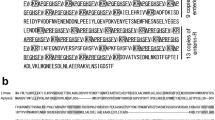Abstract
The aims of the present work were to study the role of neuropeptide CNP4, encoded by the HCS2 gene (which is expressed mainly in parietal command interneurons), in controlling the activity of the respiratory system, and also to study the effects of this neuropeptide on isolated defensive behavior neurons in prolonged culture. The influence of the command interneuron on the pneumostoma included a direct effect consisting of closure and a delayed effect consisting of intensification of respiratory movements. Application of neuropeptide CNP4 produced a pattern similar to the delayed effects seen on stimulation of the command interneuron, i.e., significant increases in the frequency and intensity of pneumostoma movements and strengthening of the rhythmic activity of the pneumostoma motoneuron. Studies of the effects of neuropeptide CNP4 on isolated neurons after prolonged culture showed that neuron process growth correlated with the presence of the neuropeptide in the medium. Identification of the location of the HCS2 precursor protein and neuropeptide CNP4 in isolated command interneurons after prolonged culture showed that that only those parts of the cell showing active process growth were immunopositive. Thus, neuropeptide CNP4 appears to be a secreted neuropeptide controlling respiratory system activity, which may also be involved in rearrangements of the network controlling defensive behavior in Helix snails
Similar content being viewed by others
REFERENCES
P. M. Balaban, “Interaction between identified neurons of defensive and respiratory reflexes in the common snail,” Zh. Vyssh. Nerv. Deyat., 31, No. 2, 315–322 (1981).
P. M. Balaban, N. I. Bravarenko, and I. S. Zakharov, “The neurochemical basis for reverse inhibition in the reflex arc of a defensive reaction,” Zh. Vyssh. Nerv. Deyat., 41, No. 5, 1033–1038 (1991).
P. M. Balaban and I. S. Zakharov, Learning and Development. A Common Basis for Two Phenomena [in Russian], Nauka, Moscow (1992).
P. M. Balaban and E. G. Litvinov, “Command neurons in the arc of an unconditioned reflex in the common snail,” Zh. Vyssh. Nerv. Deyat., 27, No. 3, 538–544 (1977).
P. M. Balaban and R. Chase, “Inhibition of cells involved in avoidance behavior by stimulation of mesocerebrum,” J. Comp. Physiol., 166, No. 3, 421–427 (1990).
P. M. Balaban, D. A. Poteryaev, I. S. Zakharov, P. Uvarov, A. Malyshev, and A. V. Belyavsky, “Up-and down-regulation of Helix Command-specific 2 (HCS2) gene expression in the nervous system of terrestrial snail, Helix lucorum,” Neurosci., 103, No. 2, 551–559 (2001).
Yu. D. Bogdanov, P. M. Balaban, D. A. Poteryaev, I. S. Zakharov, and A. V. Belyavsky, “Putative neuropeptides and an EF-hand motif region are encoded by a novel gene expressed in the four giant interneurons of the terrestrial snail,” Neurosci., 85, 637–647 (1998).
Yu. D. Bogdanov, D. A. Ovchinnikov, P. M. Balaban, and A. V. Belyavsky, “Novel gene HCS1 is specifically expressed in the giant interneurons of the terrestrial snail,” Neuroreport, 5, 589–592 (1994).
C. S. Cohan and S. B. Kater, “Modulation of neurite outgrowth: role of neurotransmitters, electrical activity and calcium,” in: Studies in Neuroscience: The Cellular Basis of Neuronal Plasticity, Manchester University Press, Manchester (1989).
K. Elekes and D. R. Nassel, “Distribution of FMRFamide-like immunoreactive neurons in the central nervous system of the snail Helix pomatia,” Cell Tiss. Res., 262, 177–190 (1990).
Z. P. Feng, J. Klumperman, K. Lukowiak, and N. I. Syed, “Synaptogenesis between the somata of identified Lymnaea neurons requires protein synthesis but not extrinsic growth factors or adhesion molecules,” J. Neurosci., 17, No. 20, 7839–7849 (1997).
P. G. Haydon, D. P. McCobb, and S. B. Kater, “Serotonin selectively inhibits growth cone motility and synaptogenesis of identified neurons,” Science, 226, 561–564 (1984).
V. N. Ierusalimsky, D. V. Boguslavsky, A. V. Belyavsky, and P. M. Balaban, “Helix peptide immunoreactivity pattern in the nervous system of juvenile Aplysia,” Brain Res. Mol. Brain Res., 12, No. 120, 84–89 (2003).
S. B. Kater and L. R. Mills, “Regulation of growth cone behavior by calcium,” J. Neurosci., 11, No. 4, 891–899 (1991).
A. Y. Malyshev and P. M. Balaban, “Identification of mechanoafferent neurons in terrestrial snail: response properties and synaptic connections,” J. Neurophysiol., 87, 2364–2371 (2002).
L. R. Mills and S. B. Kater, “Neuron-specific and state-specific differences in calcium homeostasis regulate the generation and degeneration of neuronal architecture,” Neuron, 4, No. 1, 149–163 (1990).
H. Song and M. Poo, “The cell biology of neuronal navigation,” Nat. Cell Biol., 3, No. 3, 81–88 (2001).
F. S. Walsh and P. Doherty, “Neural cell adhesion molecules of the immunoglobulin superfamily: role in axon growth and guidance,” Ann. Rev. Cell Dev. Biol., 13, 425–456 (1997).
Zhong-Yu Sun, B. Kauderer, and S. Schacher, “Differential distribution of functional receptors for neuromodulators evoking short-term heterosynaptic plasticity in Aplysia neurons,” J. Neurosci., 16, No. 23, 7540–7549 (1996).
Author information
Authors and Affiliations
Additional information
__________
Translated from Zhurnal Vysshei Nervnoi Deyatel'nosti imeni I. P. Pavlova, Vol. 55, No. 1, pp. 91–99, January–February, 2005.
Rights and permissions
About this article
Cite this article
Korshunova, T.A., Malyshev, A.Y., Zakharov, I.S. et al. Functions of Peptide CNP4, Encoded by the HCS2 Gene, in the Nervous System of Helix Lucorum . Neurosci Behav Physiol 36, 253–260 (2006). https://doi.org/10.1007/s11055-006-0007-y
Received:
Accepted:
Issue Date:
DOI: https://doi.org/10.1007/s11055-006-0007-y




